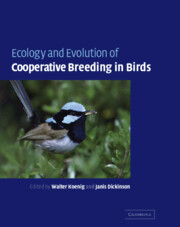Book contents
- Frontmatter
- Contents
- List of contributors
- Introduction
- 1 Evolutionary origins
- 2 Delayed dispersal
- 3 Fitness consequences of helping
- 4 Parental care, load-lightening, and costs
- 5 Mating systems and sexual conflict
- 6 Sex-ratio manipulation
- 7 Physiological ecology
- 8 Endocrinology
- 9 Incest and incest avoidance
- 10 Reproductive skew
- 11 Joint laying systems
- 12 Conservation biology
- 13 Mammals: comparisons and contrasts
- 14 Summary
- Names of bird and mammal species mentioned in the text
- References
- Taxonomic index
- Subject index
Introduction
Published online by Cambridge University Press: 02 December 2009
- Frontmatter
- Contents
- List of contributors
- Introduction
- 1 Evolutionary origins
- 2 Delayed dispersal
- 3 Fitness consequences of helping
- 4 Parental care, load-lightening, and costs
- 5 Mating systems and sexual conflict
- 6 Sex-ratio manipulation
- 7 Physiological ecology
- 8 Endocrinology
- 9 Incest and incest avoidance
- 10 Reproductive skew
- 11 Joint laying systems
- 12 Conservation biology
- 13 Mammals: comparisons and contrasts
- 14 Summary
- Names of bird and mammal species mentioned in the text
- References
- Taxonomic index
- Subject index
Summary
Cooperative breeding continues to engender considerable interest among behavioral ecologists. However, the players and issues have changed dramatically since the publication of the first Cooperative Breeding in Birds volume (Stacey and Koenig 1990a). Back then, a series of long-term demographic studies were coming to fruition, opening the door for a synthetic volume that would “search for common themes and patterns” while illustrating “the great diversity that exists among cooperatively breeding birds” (Stacey and Koenig 1990b). At the time it appeared that the “common themes and patterns” would outstrip the “great diversity” and that a general understanding of the main issues raised by the phenomenon of cooperative breeding was about to be achieved (Emlen 1997a).
Such optimism concerning a general answer to the paradox of helping behavior was quickly dismissed (Cockburn 1998), and it has continued to elude our grasp. Instead, new theoretical approaches and studies have emerged to reinvigorate the field. Three stand out in particular. First is DNA fingerprinting, which was just getting started in the late 1980s and was only minimally represented in the 1990 volume. Multilocus minisatellite fingerprinting and its descendant, microsatellite fingerprinting, provided the long-sought-after ability to determine parentage and estimate relatedness. Fingerprinting allowed those who were continuing long-term studies or who had been fortunate enough to collect and save blood samples either to confirm prior inferences regarding patterns of parentage (as in Florida scrub-jays and acorn woodpeckers: Quinn et al. 1999; Dickinson et al. 1995; Haydock et al. Haydock et al. 2001) or to turn all prior inference on its head (as in the splendid fairy-wren: Brooker et al. 1990).
- Type
- Chapter
- Information
- Publisher: Cambridge University PressPrint publication year: 2004
- 4
- Cited by



